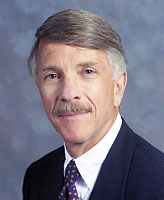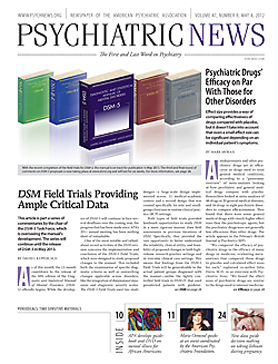One day when I was chair of psychiatry at the Medical University of South Carolina, several people came up to me and said, “Are you OK—is everything all right?” I said I was fine but I wasn’t clear why they were asking. “Oh, we heard loud shouting coming from your office yesterday, and we were just concerned.” They said they knew that I was meeting with a particular faculty member from a different department who was known to be pretty hotheaded. I said that I appreciated their concern, but that, in fact, I had been out of town that day! It was a funny episode but one that has stuck with me, illustrating how easy it is for things to be said with conviction that don’t correspond to the facts. Effective and accurate communication is not easy!
This is my last “From the President” column, and it may seem odd that I picked this topic to talk about. But as I thought about this truly special and wonderful year as your president, it seemed to me that one of our biggest challenges has been to communicate well. Sometimes the facts are not so obvious or clear-cut, and a range of opinion is inevitable. Sometimes we hear what we want to hear, and we make the “facts” fit. And sometimes we hear things that are secondhand or thirdhand, and we don’t have time to confirm what we hear with the original source.
A big part of my job last year, as president-elect, was to get up to speed on the many ongoing issues APA is dealing with and then this year, as president, to help the Board, Assembly, and APA staff work together on these issues as effectively as possible—issues like parity implementation, scope of practice, maintenance of certification and maintenance of licensure, health care reform, membership, DSM-5, and many others.
During the past year, two areas that have generated a fair amount of heat have been Maintenance of Certification (MOC) and DSM-5. MOC was seen by some members as an unwelcome, costly, expanding, and intrusive set of requirements being imposed on APA members who wished to remain board certified. Emotions ran high, and APA was perceived by some as the culprit, or, if not, at least as a coconspirator with the American Board of Psychiatry and Neurology (ABPN). Jay Scully made several presentations of the facts to the Board and Assembly, as well as to many APA components—for example, that the rules were set by the American Board of Medical Specialties as requirements for all of its 24 member boards, and that APA and ABPN had strongly objected to several aspects of the MOC requirements, and in some ways to the entire process itself, but to no avail.
Since communication is bidirectional, however, involving both sending and receiving messages, it became apparent that the most important message in play was the intensity of affect of our members. That was the message we needed to hear, and it probably took longer than it should have for “good mentalizing” to kick in! Reframing it this way helped us shape the efforts of the Board Work Group on MOC, coordinate that group’s efforts with a similar committee in the Assembly, approve the establishment of a requested Caucus on MOC, and make APA’s ABPN-approved Performance in Practice Modules available to APA members at no cost, to facilitate meeting Part 4 MOC requirements (see “Fulfill Part 4 of MOC With Free PIP Module”). Some heat is still out there and concerns remain, but I hope we are at a better place, with constructive and accurate dialogue under way.
There have been many communication challenges as well with respect to DSM-5. One example involves the proposal to delete the DSM-IV stipulation that clinicians should not diagnose depression for at least 60 days following the death of a spouse or a loved one, during this period of mourning. The proposal to remove this exception is still preliminary, but it was widely viewed as established gospel. It was picked up on the Web and quickly led to exaggerated and, yes, heated postings and e-mails. APA was intent, some suggested, on giving everyone a diagnosis—pathologizing all aspects of life. The number of diagnoses in DSM-5, some said, was certain to be greatly increased over DSM-IV. All citizens experiencing bereavement would surely be labeled with a depressive illness and given medications. And perhaps this was all driven by the pharmaceutical industry, scheming behind the scenes to influence the DSM-5 Task Force.
What are the facts? One interesting fact is that at this point it looks like DSM-5 will have a smaller number of diagnoses than DSM-IV. (A curious contrasting fact that receives little notice is that ICD-10 has about 14,000 diagnoses, and ICD-11 is predicted to contain about 60,000 diagnoses.) Regarding the bereavement exclusion, there is of course no recommendation to diagnose all who are grieving—since grief is a perfectly normal and necessary part of life. Interestingly, if one becomes depressed following a highly stressful divorce, or the loss of all of one’s possessions in a hurricane or other disaster, or the loss of a job and no way to pay the bills, depression can be diagnosed at any time following these losses, according to DSM-IV. But any of these situations, certainly including the death of a spouse, can serve as the major stress that precipitates depression in those at risk, such as patients with histories of suicidal depression. APA’s goal here is to do the best job we can to make treatment available to those who need it, not to impose treatment on those who don’t.
I could go on—these are just two of many areas where reality gets lost in the cloud and perception becomes the new reality. I have worked hard this year to represent all of you well by clarifying the facts when we know them and by being receptive to suggestions and respectful of a wide diversity of opinion—since many times there just aren’t hard-and-fast answers. And there have been lots of opportunities to spread the word about terrific accomplishments by our organization and in the world of psychiatry itself. Let me close by personally thanking all of you—members of APA—for your help and your good work on behalf of our main mission: improving the lives of our patients.

Fulfill Part 4 of MOC With Free PIP Module
APA’s Division of Education is offering free access to APA members to a new performance-in-practice (PIP) module on substance abuse screening. (Nonmembers must pay $399.) The module has been approved by ABPN to meet the practice assessment component (Part 4) for maintenance of certification (MOC) and offers 20 AMA PRA Category 1 Credits. Beginning in 2013, for psychiatrists applying for 2014 MOC examinations, Part 4 will require physicians to compare patient charts for five patients with published best practices, practice guidelines, or peer-based standards of care and develop a plan to improve effectiveness and efficiency of care delivery in their clinical practice. The performance-in-practice module can be accessed at
www.apaeducation.org/ihtml/application/student/interface.apa/index.htm?page=catalog.

